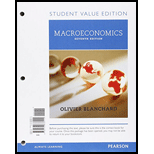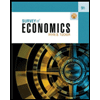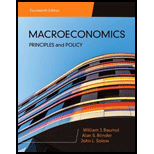
a)
To find: Whether the given statement “consumption is the largest component of
a)
Answer to Problem 1QAP
The given statement is true.
Explanation of Solution
The statement is true because it contains goods and services that are produced in an economy and which is bought by the consumer. Almost 68.3% of the GDP is composed of this component (consumption).
b)
To find: Whether the given statement “government spending, including transfer was equal to 18.1% of GDP of the year 2014” is true, false or uncertain.
b)
Answer to Problem 1QAP
The given statement is false.
Explanation of Solution
The statement is false because the government spending does not include transfers like Medicare transfer, payment related to social security, or interest payments on government debts. These are government expenditures but are not the purchases of goods and services.
Moreover, the given percentage of government spending in table 3.1 of the book is 18.1%, which is smaller than the total spending that includes transfers and interest payments.
When transfer and interest payment is including in government spending then the share will become 33% of GDP.
However, government spending is alone equal to 18.1% of GDP.
c)
To state: Whether the given statement that “the marginal propensity to consume must be positive and it can take any positive value” is true, false, or uncertain.
c)
Answer to Problem 1QAP
The given statement is False.
Explanation of Solution
Marginal Propensity to Consume (MPC) is the additional amount of expenditure set aside for consumption purposes out of every extra dollar earned by the consumers.
The statement is false because the sum of Marginal Propensity to Save (MPS) and MPC is equal to 1.
Here, the statement says that the value of MPC can be any positive value.
d)
To find: whether the given statement “in the recession of 2009, one factor was a drop in the value of the parameter c0” is true, false, or uncertain.
d)
Answer to Problem 1QAP
The given statement is true.
Explanation of Solution
The statement is true because the recession of 2009 was the result of a fall in two components out of four components of autonomous spending. The worries about the future after Bankruptcy led consumers to cut their spending, thus the co declined sharply.
e)
To find: Whether the given statement that “the fiscal policy describes the choice of government spending and taxes and is treated as exogenous” is true, false, or uncertain.
e)
Answer to Problem 1QAP
The given statement is true.
Explanation of Solution
The given statement is true because fiscal policy includes the choice of taxes (T) and spending by the government (G) to alter the level of Gross Domestic product (GDP) of a country.
However, to evaluate what would happen at given levels of G or T, it is necessary to take into consideration these choices (government spending and taxes). It is considered as exogenously given in the goods market model.
f)
To check the statement “consumption equals output in goods market” is true, false, or uncertain.
f)
Answer to Problem 1QAP
The given statement is False.
Explanation of Solution
The statement is false because consumption is a part of GDP {GDP = C + I + G + (X − M)}. Thus, the equilibrium condition for the goods market is not that the consumption itself equals the output. Thus, the given statement is false.
g)
To find whether the given statement “a rise in one unit of government spending induces a rise of one unit in equilibrium output” is true, false, or uncertain.
g)
Answer to Problem 1QAP
The given statement is False.
Explanation of Solution
The statement is false because an increase in one unit of government spending leads to an increase in a unit times the multiplier value. Thus, the statement is false.
h)
To find whether the given statement “the rise in the propensity to consume induce a decrease in output” is true or false.
h)
Answer to Problem 1QAP
The given statement is False.
Explanation of Solution
The given statement is false because the relationship between MPC and output is positive. Thus, a high value of MPC leads to the high value of multiplier and it increases the output.
Want to see more full solutions like this?
Chapter 3 Solutions
Macroeconomics, Student Value Edition Plus MyLab Economics with Pearson eText -- Access Card Package (7th Edition)
- How is the mining industry related to other Canadian labour industries? Choose one other industry, (I chose Forestry)and describe how it is related to the mining industry. How do the two industries work together? Do they ever conflict, or do they work well together?arrow_forwardWhat is the primary, secondary, tertiary, and quaternary levels of mining in Canada For each level, describe what types of careers are the most common, and describe what stage your industry’s main resource is in during that stagearrow_forwardHow does the mining industry in canada contribute to the Canadian economy? Describe why your industry is so important to the Canadian economy What would happen if your industry disappeared, or suffered significant layoffs?arrow_forward
- What is already being done to make mining in canada more sustainable? What efforts are being made in order to make mining more sustainable?arrow_forwardWhat are the environmental challenges the canadian mining industry face? Discuss current challenges that mining faces with regard to the environmentarrow_forwardWhat sustainability efforts have been put forth in the mining industry in canada Are your industry’s resources renewable or non-renewable? How do you know? Describe your industry’s reclamation processarrow_forward
- How does oligopolies practice non-price competition in South Africa?arrow_forwardWhat are the advantages and disadvantages of oligopolies on the consumers, businesses and the economy as a whole?arrow_forward1. After the reopening of borders with mainland China following the COVID-19 lockdown, residents living near the border now have the option to shop for food on either side. In Hong Kong, the cost of food is at its listed price, while across the border in mainland China, the price is only half that of Hong Kong's. A recent report indicates a decline in food sales in Hong Kong post-reopening. ** Diagrams need not be to scale; Focus on accurately representing the relevant concepts and relationships rather than the exact proportions. (a) Using a diagram, explain why Hong Kong's food sales might have dropped after the border reopening. Assume that consumers are indifferent between purchasing food in Hong Kong or mainland China, and therefore, their indifference curves have a slope of one like below. Additionally, consider that there are no transport costs and the daily food budget for consumers is identical whether they shop in Hong Kong or mainland China. I 3. 14 (b) In response to the…arrow_forward
- 2. Health Food Company is a well-known global brand that specializes in healthy and organic food products. One of their main products is organic chicken, which they source from small farmers in the area. Health Food Company is the sole buyer of organic chicken in the market. (a) In the context of the organic chicken industry, what type of market structure is Health Food Company operating in? (b) Using a diagram, explain how the identified market structure affects the input pricing and output decisions of Health Food Company. Specifically, include the relevant curves and any key points such as the profit-maximizing price and quantity. () (c) How can encouraging small chicken farmers to form bargaining associations help improve their trade terms? Explain how this works by drawing on the graph in answer (b) to illustrate your answer.arrow_forward2. Suppose that a farmer has two ways to produce his crop. He can use a low-polluting technology with the marginal cost curve MCL or a high polluting technology with the marginal cost curve MCH. If the farmer uses the high-polluting technology, for each unit of quantity produced, one unit of pollution is also produced. Pollution causes pollution damages that are valued at $E per unit. The good produced can be sold in the market for $P per unit. P 1 MCH 0 Q₁ MCL Q2 E a. b. C. If there are no restrictions on the firm's choices, which technology will the farmer use and what quantity will he produce? Explain, referring to the area identified in the figure Given your response in part a, is it socially efficient for there to be no restriction on production? Explain, referring to the area identified in the figure If the government restricts production to Q1, what technology would the farmer choose? Would a socially efficient outcome be achieved? Explain, referring to the area identified in…arrow_forwardI need help in seeing how these are the answers. If you could please write down your steps so I can see how it's done please.arrow_forward

 Survey of Economics (MindTap Course List)EconomicsISBN:9781305260948Author:Irvin B. TuckerPublisher:Cengage Learning
Survey of Economics (MindTap Course List)EconomicsISBN:9781305260948Author:Irvin B. TuckerPublisher:Cengage Learning


 Economics (MindTap Course List)EconomicsISBN:9781337617383Author:Roger A. ArnoldPublisher:Cengage Learning
Economics (MindTap Course List)EconomicsISBN:9781337617383Author:Roger A. ArnoldPublisher:Cengage Learning





